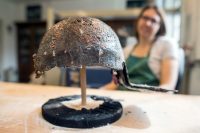 Archaeologists excavating the North Rhine-Westphalian town of Krefeld have unearthed thousands of artifacts attesting to a 1st century rebellion of Batavian tribesemen against Rome.
Archaeologists excavating the North Rhine-Westphalian town of Krefeld have unearthed thousands of artifacts attesting to a 1st century rebellion of Batavian tribesemen against Rome.
The Batavians, whose native territory was the delta between the Lower Rhine and the Waal, were long-time allies of Rome. Considered the bravest of all Germanic tribes, they had formed the core of the imperial guard since Augustus and had a special deal with the empire that exempted them from all tribute and taxes. The only resources the Batavians were required to contribute were fighting men, infantry and especially cavalry, famed for their amphibious ability to cross rivers on horseback in full armour. They contributed soldiers in far greater proportion than other Roman allies, an estimated 5,000 men out of a total population of just 35,000.
In 69 AD, the turbulent Year of the Four Emperors that followed the death of Nero, Rome pissed off the wrong Batavians. The year before Fonteius Capito, the governor of Germania Inferior had had Batavian prince Julius Paullus executed on false charges of rebellion. He sent Paullus’ kinsman Gaius Julius Civilis to Nero in chains on the same trumped up charges, but Nero died before rendering judgment. His successor Galba acquitted Civilis and sent him home. He also dissolved the Germanic bodyguard, however, and the Batavians saw this as a grave insult.
Then came the conscriptions. Roman chronicler Tacitus describes this trigger of the Batavian rebellion in his Histories in reliably salacious terms:
At the orders of Vitellius a levy of the young Batavians was now being made. This burden, which is naturally grievous, was made the heavier by the greed and licence of those in charge of the levy: they hunted out the old and the weak that they might get a price for letting them off; again they dragged away the children to satisfy their lust, choosing the handsomest — and the Batavian children are generally tall beyond their years.
Civilis, who had already decided to rebel against at Rome, used this latest outrage as a fulcrum to move the whole tribe to rebellion and soon persuaded neighboring tribes to join in the cause.
Civilis turned to force and organized the Canninefates, the Frisians, and the Batavians, each tribe in a troop by itself: the Roman line was drawn up to oppose them not far from the Rhine, and the vessels which had been brought here after the burning of the forts were turned to front the foe. The battle had not lasted long when a cohort of the Tungri transferred its standards to Civilis, and the Roman soldiers, demoralized by this sudden betrayal, were cut down by allies and foes alike. There was the same treachery also on the part of the fleet: some of the rowers, being Batavians, by pretending a lack of skill interfered with the sailors and combatants; presently they began to row in the opposite direction and bring the sterns to the bank on which the enemy stood; finally, they killed such of the helmsmen and centurions as did not take their view, until the entire fleet of twenty-four vessels either went over to the enemy or was captured.
This victory was glorious for the enemy at the moment and useful for the future. They gained arms and boats which they needed, and were greatly extolled as liberators throughout the German and Gallic provinces.
The 10-month excavation at the site near the Rhine, archaeologists found coins, weapons, helmets, a soldier’s decorated belt buckle and the skeletal remains of more than 300 horses believed to have been casualties of this battle.
The vast dig (covering almost 10 acres in area) unearthed more than artifacts from the brief window of the Batavian rebellion. Close to 6,500 graves were discovered encompassing burials over the course of a millennium, from 800 B.C. to 800 A.D., many containing significant gave goods. It is one of the largest ancient cemeteries north of the Alps.
The archaeological material is now being studied and conserved at the Burg Linn Museum where a selection of items from before, during and after the rebellion will go on display next year.